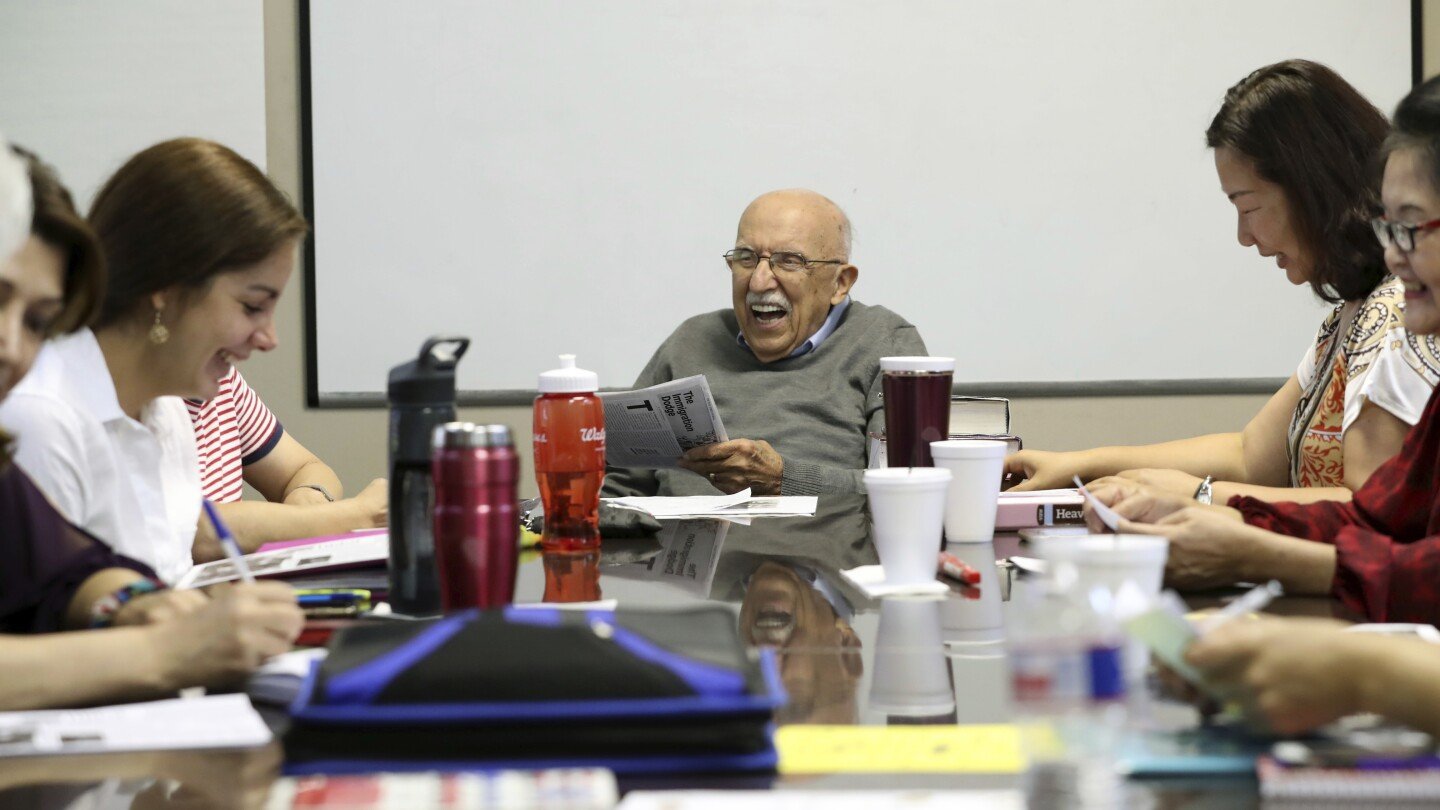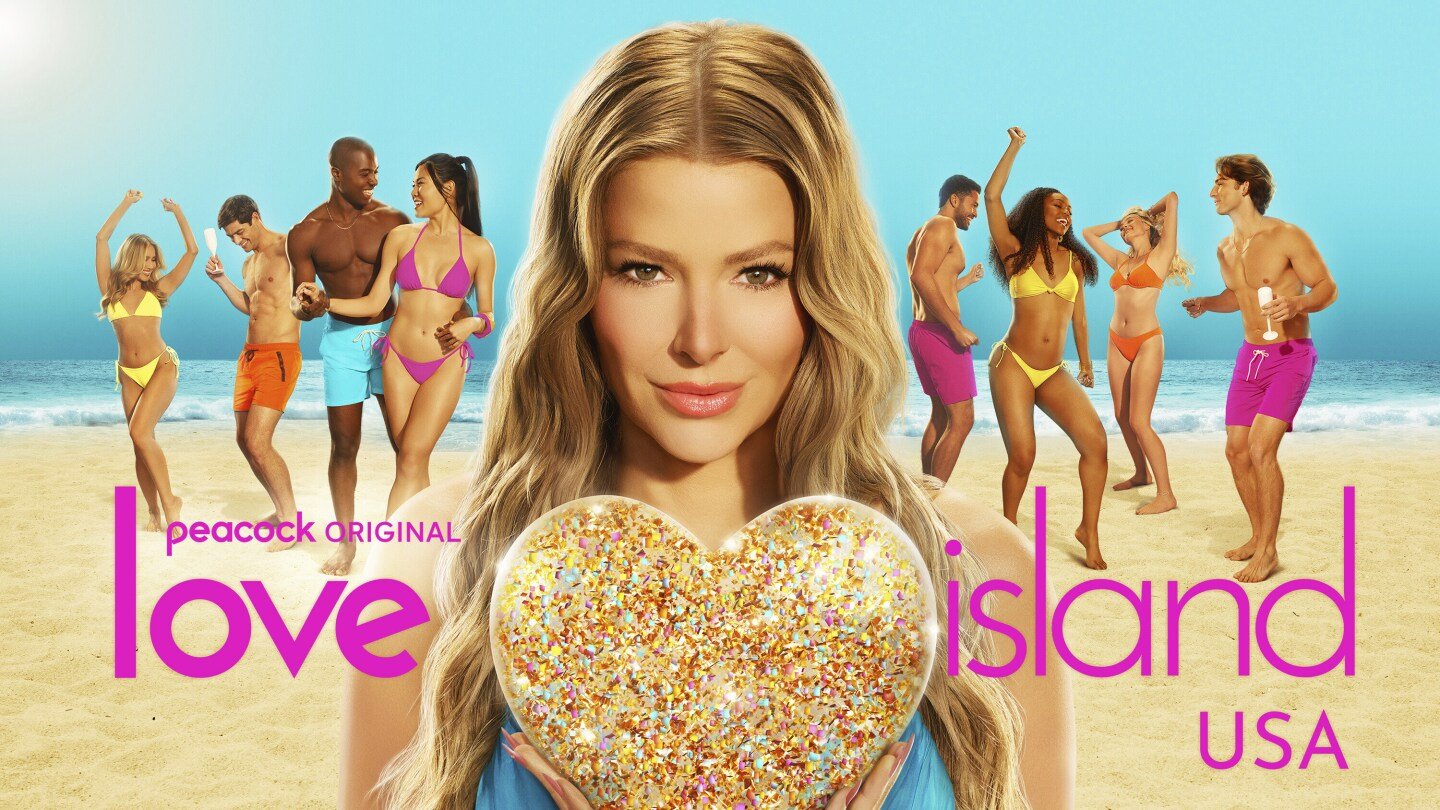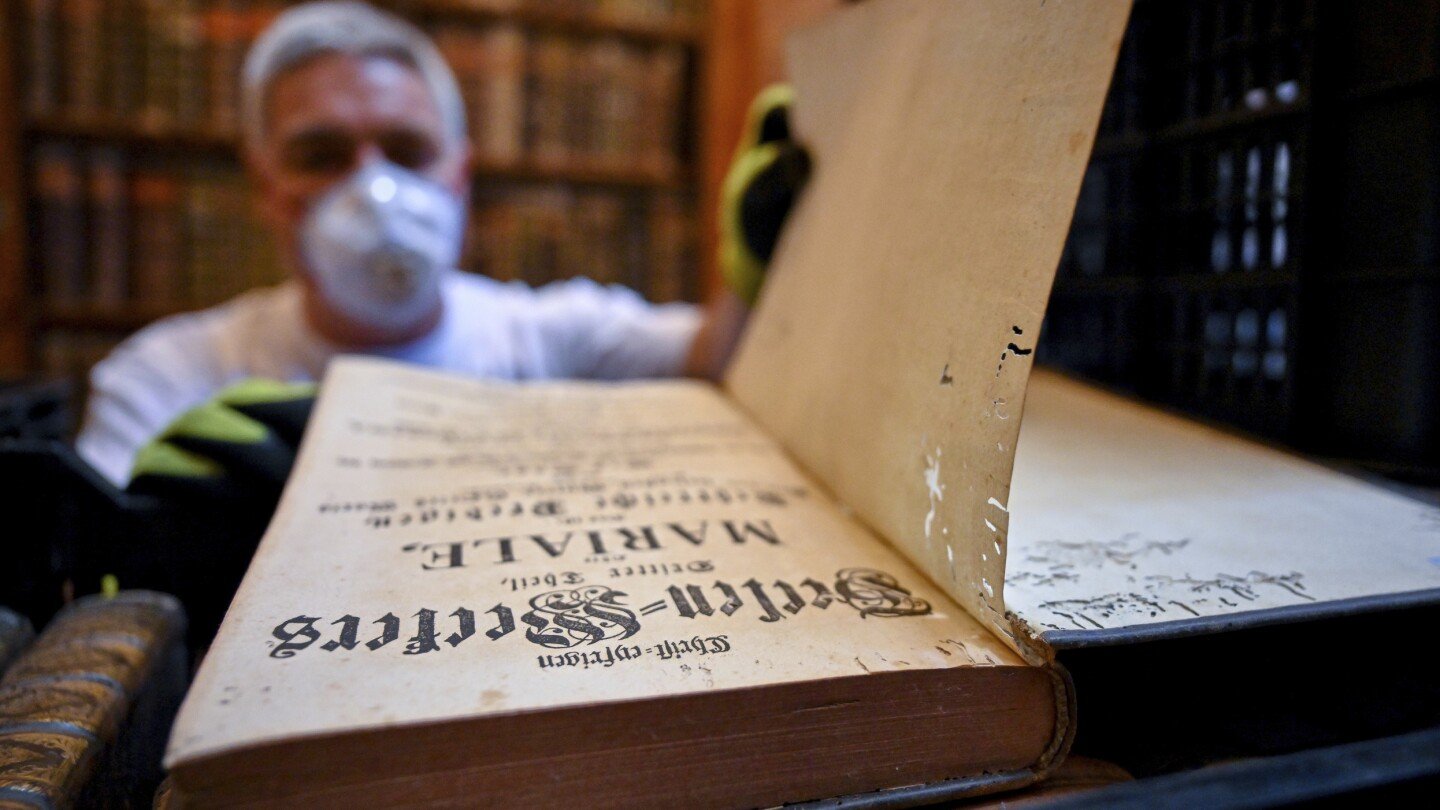Lifestyle
Growing share of US residents speak a language other than English at home

Spanish may be the most spoken language at home behind English, except in three U.S. states, but the second most-popular, non-English languages used in each state show off the diversity of the United States in unexpected places, whether it’s Korean in Alabama or Vietnamese in Kansas.
Almost 22% of U.S. residents age 5 and older spoke a language other than English at home, double the share from four decades ago, according to figures released Tuesday by the U.S. Census Bureau, and it varied by state. In California, 44% of residents spoke a language other than English at home, while it was 2.5% in West Virginia.
The United States is a multilingual nation due to immigration, despite recent crackdowns by the Trump administration, said William Frey, a demographer at The Brookings Institution.
“This is a big part of who we’ve been over a long period of time,” Frey said.
President Donald Trump earlier this year issued an executive order designating English as the official language in the U.S.
Spanish was spoken at home by 13.2% of speakers, and it was the top non-English language spoken at home in every state but Hawaii, Maine and Vermont. In Maine and Vermont, home to French Canadian communities, French was the most popular non-English language, and in Hawaii, it was Iloko, a Filipino language.
Here’s a look at where languages are spoken in the United States.
Arabic
Outside of English and Spanish, Arabic was the most spoken language at home in Iowa, Michigan, Ohio, Tennessee and West Virginia. The Detroit, Michigan, area has more Arabic speakers than any other metro area.
Central Yup’ik
About 1 out of 7 Alaskans who speak a language other than English at home did so in Central Yup’ik, making the native language the second most common non-English language behind Spanish in Alaska.
Chinese
Chinese was the second-most common non-English language spoken at home in Delaware, Missouri, New York, Pennsylvania and Washington. If all Chinese dialects are combined, it would be the third most spoken language in California behind English and Spanish.
French
Although it was the dominant non-English language in Maine and Vermont, French was the second most-common non-English language in Louisiana, Maryland, New Hampshire and North Carolina.
German
German was the most spoken language behind English and Spanish in eight states — Colorado, Idaho, Indiana, Kentucky, Montana, North Dakota, South Carolina and Wyoming. In total, more than 871,000 people over age 5 spoke German at home in 2021, compared to 1.6 million in 1980.
Haitian
Florida had almost a half million Haitian speakers, making it the most common language behind English and Spanish. The Sunshine State has the nation’s largest Haitian population.
Hmong
In Minnesota and Wisconsin, Hmong was the second-most spoken non-English language at home. Many Hmong people settled in the Upper Midwest states after fleeing Southeast Asia in the mid-1970s following the Vietnam War.
Korean
Korean was the most spoken language in Alabama and Virginia behind English and Spanish.
Lakota
In South Dakota, the Lakota dialect of the Sioux people was the most common language spoken behind English and Spanish.
Marshallese
The language of the Marshall Islands was the second-most spoken non-English language in Arkansas, where the community is concentrated in the northwest part of the state.
Navajo
Arizona and New Mexico had the most Navajo speakers in the United States. The Navajo Nation extends into Arizona and New Mexico, where the indigenous language was the second-most popular non-English speech in those two states.
Polish
Despite a nationwide decline in speakers, Polish was Illinois’ second-most common non-English language behind Spanish, primarily due to the Chicago area having one of the nation’s largest Polish communities.
Portuguese
Connecticut, Massachusetts, New Jersey and Rhode Island have some of the largest concentrations of Portuguese speakers in the U.S., making it the most spoken language in these states behind English and Spanish. It also is the second-most common non-English language in Utah, which is home to missionaries who served in Brazil and explains its popularity, according to the University of Utah.
Tagalog
The Filipino language was prevalent in California, Hawaii and Nevada, where it was the second-most popular non-English tongue.
Vietnamese
In Georgia, Kansas, Mississippi, Nebraska, Oklahoma, Oregon and Texas, Vietnamese was the most popular language behind English and Spanish, reflecting that people who speak different languages are no longer concentrated in big cities that serve as entry points for immigrants.
“People of different backgrounds are dispersed to different parts of the country,” Frey said.
___
Follow Mike Schneider on the social platform Bluesky: @mikeysid.bsky.social.
Lifestyle
Most teens see college as key to jobs and life skills, AP-NORC poll says

PHOENIX (AP) — Most American teenagers say it is important to them to graduate from college, with girls especially describing it as a key step for accomplishing their life goals, according to a new poll.
Teenagers also generally are more upbeat than adults on college despite concerns about tuition costs, soaring student loan debt and the politicization of many issues in higher education.
Overall, about 6 in 10 teens say it’s “extremely” or “very” important to them to graduate from college, according to the survey from The Associated Press-NORC Center for Public Affairs Research, which was conducted this spring among teenagers between the ages of 13 and 17. That compares with about 4 in 10 adults who said the same in a UChicago Harris/AP-NORC poll from 2022.
The survey also found that many teens think it will be harder for them to achieve major life milestones — like owning a home, raising a family or reaching a good standard of living — than it was for their parents.
For Ry-n Uyeda, 17, the biggest concern about college is the prospect of being away from her home in Waianae, Hawaii. Uyeda is already taking college-level courses in high school and hopes to play softball at a university on the West Coast.
Uyeda said she wants to develop time management skills and endurance to handle the pressures of being a student-athlete. But she hopes the college experience does not change who she is.
“I want to remember where I came from and the values that I’ve learned from here,” said Uyeda, who attends Waianae High School. “Going to a new place with new people in a new environment, I just want to still be myself.”
Far more girls than boys see value in college
Seven in 10 teenage girls in the survey said it was at least “very” important to them to graduate from college, compared with 54% of teenage boys.
The disparity reflects a growing gender gap in college degree completion. In 1995, young men and women were equally likely to hold a bachelor’s degree. Since then, a gap has emerged, with 47% of U.S. women ages 25-34 completing a bachelor’s degree compared with 37% of men, according to a Pew Research Center analysis of census data.
Teens raised in households with higher incomes and parents who went to college themselves also are more likely to view higher education as important.
Jalena Crawford, a 16-year-old high school junior, said she hopes to attend Grand Canyon University or Arizona State University to become a professional American Sign Language interpreter. She said her plans have been encouraged by relatives with college degrees and it would be “weird” not to consider higher education.
“I didn’t really start thinking about college until I started liking ASL. I was trying to figure out what I was going to do,” Crawford said.
Most teens see a college education as a vital step for their future career prospects, although they see other benefits as well.
About 7 in 10 teenagers said completing college is “extremely” or “very” important for getting good jobs, and about 6 in 10 teenagers say a degree is valuable in learning necessary life skills. About half of teens see college as key for either becoming a more informed member of society or forming their personal identity, according to the survey.
Teens think life milestones will be harder for them to achieve
Teenagers have many of the same life goals as adults, such as owning a home and raising a family, the poll found. About 8 in 10 teenagers value being able to pursue what they enjoy, having a good standard of living and having a successful career.
But few teenagers believe those goals have gotten easier to achieve for their generation compared with their parents.
About 7 in 10 teenagers believe owning a home has become harder to achieve for them compared with their parents, according to the poll. Just over half of teenagers say it’s become more challenging for their generation to raise a family. About half say that about having a good standard of living, having a successful career or traveling the world. Fewer, about 4 in 10, say it’s grown harder to graduate from college or be able to pursue what they enjoy.
Evarist Bego, 22, graduated earlier this year from the University of Southern California with a joint degree in business and film. He said he recalls wanting to go to college and then work his way up in his chosen industry but “that’s just not how it works anymore.”
It’s harder than he anticipated to find a job, which he said may owe partly to the creative industry he chose. He sees mostly temporary positions, like internships or fellowships.
“So many jobs that I see are entry-level, but then they require three-plus years of experience. I have interned in school, I had some experience, but it’s not enough,” he said.
___
Sanders reported from Washington.
___
The Associated Press’ education coverage receives financial support from multiple private foundations. The AP is solely responsible for all content. Find the AP’s standards for working with philanthropies, a list of supporters and funded coverage areas at AP.org.
___
The AP-NORC poll of 1,060 teens ages 13-17 was conducted April 30-May 14, using a sample drawn from NORC’s probability-based AmeriSpeak Panel Teen Panel, which is designed to be representative of teenagers in the U.S., and interviews from opt-in online panels. The margin of sampling error for teens overall is plus or minus 4.2 percentage points.
Lifestyle
Love Island sparks debate about race and dating among Black women

It used to be that dating was as simple as deciding between dinner, a trip to the movies or an arcade. Now, understanding the dating scene has become intermingled with smartphones, matchmaking apps and one’s ability to navigate thorny social issues like racial preference in a mate.
“Love Island,” a widely popular international reality television franchise, is emblematic of the complexities of modern dating. It has also sparked heated discussions among fans about the desirability of Black women and darker-complexioned people both on and off air.
The show, which aired the finale of the seventh season of its U.S. version Sunday and is airing the 12th season of its U.K. version, casts conventionally attractive “islanders” who are generally in their early to late 20s for a six- to eight-week stay in a luxury villa. Men and women compete for long-lasting relationships and a cash prize.
But as the show’s daters face challenges meant to test their bonds, as well as elimination by villa mates or by fans’ vote, notions of who is and isn’t desirable frequently come up for viewers and contestants alike. In the end, many fans are left with the perception that racial bias, colorism and misogyny are especially inescapable for Black women on reality dating shows.
“The diversity in the U.K. one is terrible,” said Oghosa Ovienrioba, a content creator from London. “It’s very anti-Black.”
It’s not simply that Black women are picked last for coupling or eliminated first on the U.K. or U.S. versions of the show. Many fans say there’s a recurring theme of suitors dumping or ditching Black female contestants when there is a fairer skinned option. Black female contestants have also complained of not doing well on the show when they don’t lower their standards for intimacy with a suitor, as though they are lucky to even been considered dating material among more desirable mates.
Even with these viewer frustrations, Ovienrioba said she prefers “ Love Island USA.”
“I feel like the dark skin Black women on that show always find men who fit their vibe, who respect them, who are attracted to them, desire them, treat them like queens,” she said.
‘Love Island’ U.K. irks fans over treatment of Black women
In the U.K. version, fans have counted multiple instances where Black female contestants were left as the last choice when couples were picked, or they were first to get eliminated and dumped from the villa. Many have also noted that it took eleven seasons before a darker-complexioned Black woman was declared the winner.
Now in its 12th season, Love Island U.K. is still dogged by allegations of male contestants’ bias against Black women. After 23-year-old Alima Gagigo, a Black woman, chose to couple up with 26-year-old Blu Chegini, a white man, he said, “I’ll be honest, on paper, you’re not my type.”
Gagigo responded, “Of course,” as if those were words she was not surprised to hear.
There is no evidence that Chegini was referring to Gagigo’s race or ethnicity. But the exchange was enough to confirm what some in audience felt was an implicit bias against Black women in the villa.
“Love Island’s only stipulation is that applicants are over 18, single and looking for love. Our application and casting process is inclusive to all and we are always aiming to reflect the age and diversity of our audience on the show,” a show spokesperson for “Love Island U.K.” said.
Black American contestants, too, say their complexion impacts their treatment
JaNa Craig, a contestant on “Love Island USA’s” beloved sixth season, which aired last summer, landed a spot in the final four couples by the end of the competition alongside Kenny Rodriguez, who entered the villa 13 days into the season. Her bubbly personality made her a fan favorite.
Although she initially worried about how viewers felt about her, the positive audience reaction culminated in her being deemed the “baddest girl in Love Island history,” which means hot or beautiful in slang terms. Still, she felt some male contestants may not have been interested in her and Serena Page, another Black female contestant, because of their skin complexion. Page went on to win that season of “Love Island USA.”
“The very first time I felt special is when the very first guy picked me because he had three options. Other than that, I always felt like I was getting the short end of the stick,” Craig said. “Even though we know our worth and we know we’re beautiful, we still felt like — not good enough.”
Ultimately, Craig felt proudest when she heard from other Black women who said they appreciated her representation on the show, given the perception that Black women are less desirable on dating shows.
“I felt honored by the amount of Black girls that were like, ‘JaNa, you inspire me,’” she said.
“Love Island USA” producer Peacock, which on Sunday debuted a spinoff to its popular Season 6 season, titled “Love Island: Beyond the Villa,” declined comment for this story.
Desirability concerns reflect real-world anti-Black sentiments
Fans’ and contestants’ concerns about Black women’s representation on the show reflect a real-world anti-Black and misogynistic views of Black women, commonly referred to as misogynoir. Scholars describe it as both implicit and explicit contempt for Black women, much of it rooted in racist stereotypes that are perpetuated in popular culture and mass media. While Love Island contestants are not being outright racist to Black female competitors, many viewers feel the interactions Black women have had on the show have been laced with implicit bias.
Few viewers see anything wrong with “Love Island” contestants being open about the specific traits they look for in potential suitors. Tall over short, fit over average build, tattooed over unmarked.
But contestants’ racial preferences, whether real or simply perceived by fans of the show, can’t be seen as objective truth about who is or is not desirable in the world, said Alexandria Beightol, host of the podcast “Apathy Is Not An Option” at the Southern Poverty Law Center, a civil rights and legal advocacy nonprofit.
“You recognizing you have a type should also be you recognizing you are a product of a lot of mass media,” Beightol said.
The show’s producers should see the show’s popularity as an opportunity to dispel and not reinforce notions of beauty, especially ones harmful to Black women and darker-complexioned people, she added.
“It would behoove you to have some producers that look like some of the women on there who can kind of anticipate some of that drama,” Beightol said. “They do frame those women as beautiful. In the history of reality programming, they’ve busted through a lot of the implicit views that the media used to hold itself to.”
Lifestyle
Hungary’s oldest library is fighting to save 100,000 books from a beetle infestation

PANNONHALMA, Hungary (AP) — Tens of thousands of centuries-old books are being pulled from the shelves of a medieval abbey in Hungary in an effort to save them from a beetle infestation that could wipe out centuries of history.
The 1,000-year-old Pannonhalma Archabbey is a sprawling Benedictine monastery that is one of Hungary’s oldest centers of learning and a UNESCO World Heritage site.
Restoration workers are removing about 100,000 handbound books from their shelves and carefully placing them in crates, the start of a disinfection process that aims to kill the tiny beetles burrowed into them.
The drugstore beetle, also known as the bread beetle, is often found among dried foodstuffs like grains, flour and spices. But they also are attracted to the gelatin and starch-based adhesives found in books.
They have been found in a section of the library housing around a quarter of the abbey’s 400,000 volumes.
“This is an advanced insect infestation which has been detected in several parts of the library, so the entire collection is classified as infected and must be treated all at the same time,” said Zsófia Edit Hajdu, the chief restorer on the project. “We’ve never encountered such a degree of infection before.”
Abbey houses historical treasures
The beetle invasion was first detected during a routine library cleaning. Employees noticed unusual layers of dust on the shelves and then saw that holes had been burrowed into some of the book spines. Upon opening the volumes, burrow holes could be seen in the paper where the beetles chewed through.
The abbey at Pannonhalma was founded in 996, four years before the establishment of the Hungarian Kingdom. Sitting upon a tall hill in northwestern Hungary, the abbey houses the country’s oldest collection of books, as well as many of its earliest and most important written records.
For over 1,000 years, the abbey has been among the most prominent religious and cultural sites in Hungary and all of Central Europe, surviving centuries of wars and foreign incursions such as the Ottoman invasion and occupation of Hungary in the 16th century.
Ilona Ásványi, director of the Pannonhalma Archabbey library, said she is “humbled” by the historical and cultural treasures the collection holds whenever she enters.
“It is dizzying to think that there was a library here a thousand years ago, and that we are the keepers of the first book catalogue in Hungary,” she said.
Among the library’s most outstanding works are 19 codices, including a complete Bible from the 13th century. It also houses several hundred manuscripts predating the invention of the printing press in the mid-15th century and tens of thousands of books from the 16th century.
While the oldest and rarest prints and books are stored separately and have not been infected, Ásványi said any damage to the collection represents a blow to cultural, historical and religious heritage.
“When I see a book chewed up by a beetle or infected in any other way, I feel that no matter how many copies are published and how replaceable the book is, a piece of culture has been lost,” she said.
Books will spend weeks in an oxygen-free environment
To kill the beetles, the crates of books are being placed into tall, hermetically sealed plastic sacks from which all oxygen is removed. After six weeks in the pure nitrogen environment, the abbey hopes all the beetles will be destroyed.
Before being reshelved, each book will be individually inspected and vacuumed. Any book damaged by the pests will be set aside for later restoration work.
Climate change may have contributed
The abbey, which hopes to reopen the library at the beginning of next year, believes the effects of climate change played a role in spurring the beetle infestation as average temperatures rise rapidly in Hungary.
Hajdu, the chief restorer, said higher temperatures have allowed the beetles to undergo several more development cycles annually than they could in cooler weather.
“Higher temperatures are favorable for the life of insects,” she said. “So far we’ve mostly dealt with mold damage in both depositories and in open collections. But now I think more and more insect infestations will appear due to global warming.”
The library’s director said life in a Benedictine abbey is governed by a set of rules in use for nearly 15 centuries, a code that obliges them to do everything possible to save its vast collection.
“It says in the Rule of Saint Benedict that all the property of the monastery should be considered as of the same value as the sacred vessel of the altar,” Ásványi said. “I feel the responsibility of what this preservation and conservation really means.”
-

 Sports3 days ago
Sports3 days agoBill Ackman: Swift backlash after billionaire’s pro debut
-

 Europe5 days ago
Europe5 days agoBondi and Hegseth might be messing up — but they’re doing what Trump picked them to do
-

 Asia5 days ago
Asia5 days agoSouth Korea’s former President Yoon Suk Yeol back in custody over insurrection probe
-

 Asia3 days ago
Asia3 days agoAir India crash: Engine fuel supply was cut just before Air India jet crash, preliminary report says
-

 Europe3 days ago
Europe3 days agoGerman tourist found alive 12 days after she was lost in the Australian Outback
-

 Africa5 days ago
Africa5 days agoTop European court delivers series of damning rulings against Russia
-

 Europe3 days ago
Europe3 days agoAs South Korea becomes a key arms supplier to US allies, its best customer is on the edge of a warzone
-

 Africa5 days ago
Africa5 days agoGreece blocks asylum claims after surge in migrant arrivals




